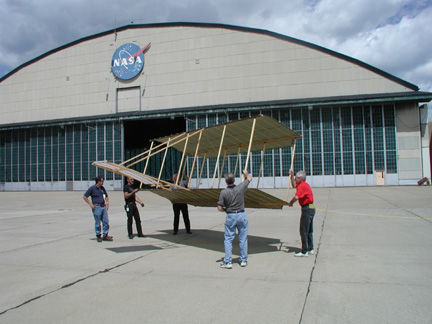Interactive Performance Prediction
Our Wright 1900 replica weighs 60 pounds. For our full scale replica of the Wright 1900 aircraft, we have a wing area of 170 square feet. We are going to fly the aircraft at the NASA Glenn hangar which is 700 feet above sea level, so the air density is near the standard .00237 slugs/cubic foot. The lift coefficient used in the program is based on a thin flat plate at an angle of attack which you input. The only other variable we need to determine the lift is the wind velocity which you also input.

Engineers make mathematical predictions of the performance of any new aircraft as part of the design process. These predictions use the best data and mathematical techniques which are available to the engineer. As the Wright brothers were designing their first aircraft, the basic principles of aerodynamics were being discovered. The brothers had preliminary data on the lift coefficient of airfoils based on Lilienthal’s flights. The lift coefficient is just a number which contains all of the complex effects of shape, angle of attack, compressibility, and viscosity on the lift of an object. The lift coefficient is used in the basic lift equation. Lift (L) is equal to the lift coefficient (cl) times one half the air density (r) times the velocity squared (V^2) times the wing area (A).
L = .5 * cl * r * V^2 * A
If you know the lift coefficient, you can use the lift equation to determine the value of one unknown parameter when you are given the value of all the other variables. For example, you can determine how fast you have to fly to lift a certain weight with a given wing area. Or you can compute how big a wing you need to lift a certain weight at a given speed. Or you can compute how high you can fly with a given weight at a given speed with a given wing area. The lift coefficient is hard to determine in general. It is usually determined through wind tunnel testing. For some simple shapes, like a flat plate, or a plate with very small curvature, there are theories which give values for the lift coefficient.
NOTICE: In this simple program we have approximated the entire aircraft (both wings and the canard) by a single flat plate. So you can expect that our answer is only going to be a very rough estimate. Engineers used to call this a “back of the envelope” answer, since it is based on simple equations which you can solve quickly. Engineers still use these kinds of approximations to get an initial idea of the solution to a problem. But they then perform a more exact (usually longer, harder, and more expensive) analysis to get a more precise answer.
